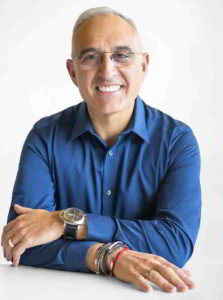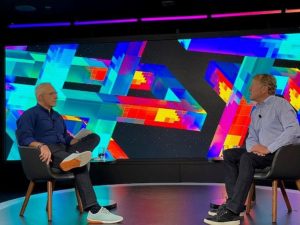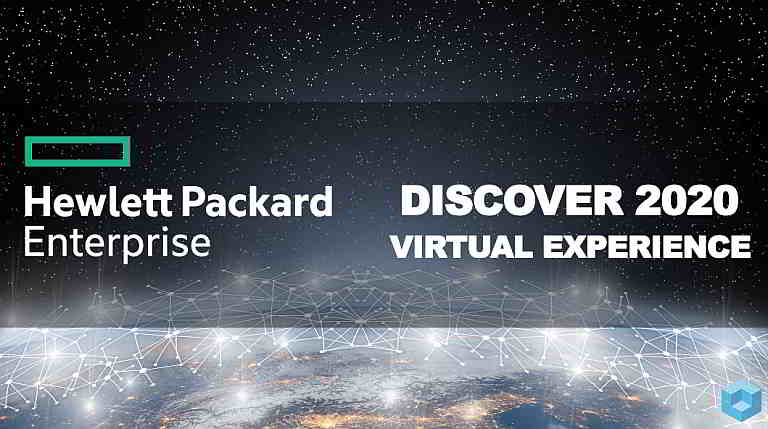
Antonio Neri, President & CEO, HPE
UPDATED: HPE Discover was a virtual event this year with HP Enterprise (HPE) conducting more than 150 sessions, demos, and training sessions conducted live and on-demand. HPE also managed to bring a little bit of Las Vegas to this virtual experience (Vegas Neon) — past events were conducted in this city. HPE made some announcements around its new cloud services and its software portfolio (Greenlake and Ezmeral). Delivering the keynote at HPE Discover Virtual Experience, Antonio Neri, President & CEO, HPE said, “We want to make everything available as a service by 2022.” He talked about the new age of insights that we are entering. “We believe in collecting data to providing insights to the business,” he said. Executives also spoke about HPE’s edge-to-cloud platform as a service strategy, which was announced last year. Joining Antonio for a pre-recorded session was John Chambers, former Executive Chairman and CEO of Cisco Systems.
Antonio’s keynote was divided into three parts. The first part was on how HPE is helping its customers to return to business with connectivity, cash flow, and business continuity. “At HPE we want to advance the way people live and work. And HPE exists to solve challenges like these (global pandemic). We consider it our responsibility to help the world navigate this pandemic. We want to support our customers and partners as we weather this storm together,” said Antonio. “Three years ago, we predicted the enterprise of the future will be cloud-centric, cloud-enabled and data-driven. Today it is no longer a prediction but a reality.”
Antonio said the edge-centric world needs technology, people, and financial flexibility. And he told us how HPE is working to deliver all three to help customers accelerate their transformations.
HPE undertook some initiatives during the pandemic. It designated $2bn in financial services to help its customers and partners who face financial hardships. For example, it supported the May Seed Company in Turkey by providing financial assistance. May Seed delivers crop seed to more than 40 countries.
HPE solutions are helping scientists with drug discovery, enabled by AI and machine learning capabilities.
Tech for Good
Aruba Networks capabilities (WiFi networks and connectivity) were deployed to help front-line medical workers during the pandemic. For instance, a ship in Italy was converted to a hospital and Aruba Networks provided the network infrastructure. Aruba is enabling COVID-19 testing centres with connectivity.
Aruba is also helping schools get back on track by providing connectivity so that they can start virtual classroom sessions. An example is Bentonville Schools in the state of Arkansas, which moved 18,000 students and 1,200 teachers to virtual learning.
HPE solutions are helping scientists with drug discovery, enabled by AI and machine learning capabilities. HPE gave scientists at the University of Alabama access to its supercomputer and high-performance computing resources to fight COVID-19. It also joined forces with the US government and other institutions for this purpose.
Another example is Cerner Health care, a supplier of health information technology solutions, services, devices, and hardware. The 40-year old company has been focussing on digitizing health care. It is now taking its big data and EMR platforms and driving insights to improve health care for its clients in the provider space. When the UK’s NHS (National Health Service) needed to expand hospital capacity, Cerner helped to transform a convention centre in London to a 100-acre hospital with 4,000 beds in a few days. This had to be done quickly because of the surge in COVID-19 cases. HPE helped Cerner with additional hardware capacity. HPE also helped the consulting practice to become prepared with new processes and workflows.
As the world reopens and businesses return to work, the focus is on employee health care, safety at the workplace, social distancing, contact tracing and tracking.
Return to work solutions
As the world reopens and businesses return to work, the focus is on employee health care, safety at the workplace, social distancing, contact tracing and tracking. HPE launched five new Pointnext return to work services to help organizations accelerate business recovery and reopening plans in the wake of COVID-19. The new solutions, which will assist in controlling the spread of the virus and enabling business continuity, will be implemented and managed through HPE Pointnext Technology Services for a fast, seamless transition. These solutions will scale for businesses of all sizes using secure, high-performing HPE servers for the edge, Aruba AI-powered network infrastructure, and technologies from HPE’s rich ecosystem of partners.
HPE has been working closely with customers that have experienced disruption due to COVID-19 related shutdowns and has helped keep their businesses running by building or enhancing remote work capabilities. Examples include implementing improved, secure connectivity and VDI solutions to support a teleworking staff. Additionally, to help customers conserve capital and lower financial risk, HPE offered $2 billion in financing and new programs through HPE Financial Services. These offerings include deferred or reduced expenses, short-term rentals, and generating cash by converting existing, owned IT assets into capital that can be applied to purchase new, upgraded technology.
The five new return-to-work solutions HPE introduced today will address the next phase for customers who are anticipating at least a portion of their employees to safely return to their regular place of work in company facilities. HPE’s customers that have already begun implementing these solutions range from large international airports and global food processing and packaging plants to retail stores and corporate offices.
These new solutions include social distance tracing and tracking, touchless entry, fever detection, augmented reality and visual remote guidance, and workplace alerts and information sharing.
HPE also released a new report titled “The New IT Playbook for Disruptive Times”. The report offers strategies and best practices for accelerating successfully into the next era.
More than 70% of enterprise apps are still not on the public cloud and therefore there are two operating models: cloud and on-premise.
The new Age of Insight
The second part of the keynote was about the new age of insight. Antonio spoke about the massive amounts of data collected in the last decade. Even in the early days of the pandemic an enormous amount of data was collected, but it couldn’t be analyzed, resulting in conflicting answers.
“Despite decades of investments in technology, there remain hundreds of dark unconnected pools of data. Researchers were overwhelmed by the volume of data, unable to create insight and action from oceans of information. I believe we are nearing the end of the information era which focussed on generation and collection of massive amounts of data. This data could not be brought together to create timely insights and actions to change our future. The next decade will be about insights and discoveries,” said Antonio.
HPE envisages an edge-to-cloud platform that will enable the movement of data without constraint so that this data can be pooled into one place and then analyzed for insights. And this will be optimized for a highly distributed business model. To get that right, HPE needs to prioritize the workloads in the data center or on the edge.
More than 70% of enterprise apps are still not on the public cloud and therefore there are two operating models: cloud and on-premise. And therefore the cloud has to be brought nearer to the workloads.
“In the next wave of digital transformation, we will shift from a cloud-first mandate to a cloud everywhere mandate,” said Antonio.
The future of Digital Transformation
To discuss the next wave of digital transformation, Antonio had a pre-recorded discussion with John Chambers, Founder and CEO of JC2 Ventures. Chambers is also the former Executive Chairman and CEO of Cisco Systems.

Antonio Neri (Left) in conversation with John Chambers (right)
Chambers, who has experienced six different market crises, had some good advice to offer business leaders who are now impacted by the pandemic.
“Business leaders do not hide (in such times). They need to be very transparent. Secondly, they need to be very realistic about how much they were impacted and how much the company needed to change. Then they need to identify five to seven platforms that will lead them through the crisis and prepare them for the outcome. They need to anticipate what it will look like 12 – 18 months ahead, paint that picture and communicate that to partners, customers, and shareholders. Communicate regularly on how you are moving towards those objectives,” said Chambers.
Chambers also urged business leaders to reinvent themselves, learning from experiences, and think about what they would do differently in the future.
Speaking about the next wave of digital transformation, Chambers said the first 40 – 50% of Fortune 500 companies will not exist in the next decade. And 60% of startups won’t exist in a decade.
“We are going to see brutal change. So it is a period of time when you either disrupt or get disrupted. Your ability to compete not against competitors but to compete against new market transitions, business models, all outcome focussed enabled by the Internet of Everything, big data and be able to analyze that, and then do the compute, from storage to access to big data, the applications, and security, at the edge — and this gives a company a chance to truly transform themselves,” said Chambers.
What Chambers was trying to convey is that change and disruption are inevitable and unless a company moves forward and embraces cutting edge technology from the edge to the cloud, they have little chance of surviving in the next decade, which will be about drawing business insights from data to make good decisions.
The “edge” that they both were talking about refers to infrastructure that is distributed and nearer to customers, partners, and employees who work from remote locations. And this is more relevant today than ever. So the world is moving from a centralized to a decentralized model, and apps and infrastructure will need agility for this model.
A new portfolio of Cloud Services
In the third part of the keynote, Antonio discussed how HPE’s expanded portfolio of new cloud services and software portfolio will help businesses transform their infrastructure for this new distributed model where everything will be available as a service. Gartner calls this the “distributed cloud.” The intelligence will also need to move close to the data to provide real-time insights. In preparation for this, HPE is moving from products to services with a roadmap to deliver an entire portfolio of cloud services by 2022.
“We want to transform HPE to an edge-to-cloud service company by 2022,” said Antonio. “The problem today is that 70% of apps were not built for the cloud and they are not open. With HP Greenlake we deliver cloud services to your data, with one consistent operating model and with visibility and governance of all your apps and data.”
To address this HPE announced its next generation of Greenlake Cloud Services. HPE claims these new services can deliver an agile, lower cost, and consistent cloud experience everywhere.
The new HPE GreenLake cloud services, which span container management, machine learning operations, VMs, storage, compute, data protection, and networking, help customers transform and modernize their applications and data – the majority of which live on-premises, in colocation facilities, and increasingly at the edge.
“Now more than ever, given current market conditions, organizations have an urgent need to connect and leverage all of their applications and data in order to transform their businesses, support their employees, and serve their customers,” said Antonio. “As we enter the next phase of the cloud market, customers require an approach that enables them to innovate and modernize all of their applications and workloads, including those at the edge and on-premises. By delivering a consistent cloud experience everywhere through HPE GreenLake cloud services, and software designed to accelerate transformation, HPE is uniquely positioned to help customers harness the full power of their information, wherever it resides.”
A brand new software portfolio
HPE also unveiled HPE Ezmeral, a new brand and software portfolio designed to help organizations transform their applications, data, and operations, from edge to cloud. HPE Ezmeral spans a complete portfolio, including container management, AI/ML and data analytics, cost control, IT automation and AI-driven operations and security, that enables organizations to increase agility and efficiency, unlock insights, and accelerate innovation. The HPE Ezmeral Container Platform and HPE Ezmeral ML Ops will be made available as HPE GreenLake cloud services to bring even greater speed and simplicity to containerized application development, and DevOps agility to the ML lifecycle.
DC Analysis
HPE is following the trend of cloud services companies bringing the cloud closer to on-prem. Distributed work environments are more relevant than ever. And most of the enterprise applications and workloads have yet to move to the public cloud and are nearer to the organizations that own them. Private clouds and hybrid clouds are more common. But eventually, we will see micro data centers with processing capability nearer to the data and the workloads — at the edge. Urgent processing tasks will happen at these micro data centers and the results will be synchronized to the “mothership” or the central cloud.
So companies like HPE are trying to bring cloud services closer to the edge with services like Greenlake which are tailored for distributed environments.
With HPE Ezmeral we believe HPE is moving into an area dominated by VMware (Tanzu) and Red Hat (Open Shift). The container software battle heats up as HPE now has its own open-source, cloud-native Kubernetes container software. We’ll have to wait and watch how customers who already opted for either VMware or Red Hat’s container software, accept Ezmeral.
And because Ezmeral has AI and ML capabilities, AWS SageMaker also has a new competitor!
The COVID connection
In this article, we described the various initiatives undertaken by HPE to help research and health care institutions around the world fight COVID-19. HPE is also offering financial assistance to customers and partners whose businesses have been impacted by the pandemic.
But HPE is also donating to charity.
For each registration for this virtual event, HPE donated $10 to charities helping others to cope with COVID-19. HPE CEO Antonio Neri admitted that he himself contracted the virus but is recovering well from his illness.
We wish him a speedy recovery!
With additional input from HPE Press Releases









